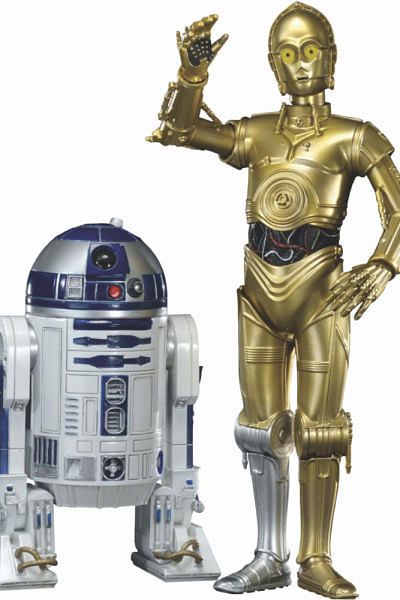What robots tell us about ourselves

When writing about robots, it's almost a reflex to begin by referring to them as an enduring science fiction trope – momentarily forgetting that they are already present in the real world. Robots, intelligent machines, are present on our factory floors, our disaster areas and in certain areas of East Asia they can even be found mixing cocktails. So clearly these machines are mundane. However, what remains fantastical and fascinating is the idea of the human-like robot: the android, the Artificial Intelligence.
The robot that is in our own image is the great promise and danger of science fiction. This is the concept of an entity that is at once person and object. This dual nature is impossible for the human mind to grasp and all stories fall short when attempting to discuss it. Inevitably the author leans towards treating the robot as either a machine or as a person, and the choice speaks volumes about the cultural context the story was written in.
It is common knowledge that the term "robot" is rooted in a Hungarian word for "forced labourer". It is an appropriate term as early science fiction generally explored their nature as servant and object. The trope is embedded in the housekeeping robots of The Jetsons, the butler-esque C-3PO and the character of R2-D2 who behaves like a mischievous, clever but ultimately loyal pet. One of the most iconic contributions to our conception of the future robot came from Isaac Asimov, who formulated the Three Laws of Robotics in his anthology I, Robot. These laws shackled robots with three all-encompassing principles that would see them unable to harm humanity or let humanity come to harm. This is unprecedented: humans have had master-slave relationships with other species (and even other humans) since prehistory but we have never utterly subsumed a thinking mind's sense of self-preservation. The robot, according to the influential Asimov, will be the first non-human that will by default choose to die for us.
This objectified view of robots must be placed in the cultural context: greater industrialisation had cemented machinery in the popular consciousness as both the source of great wealth and danger. Robots of a primitive nature were already entering the manufacturing process and the advent of computing only accelerated the process. By the time Asimov wrote the nature of robots as essentially servants, it was an established fact. We are familiar with the fear of job loss in the face of mechanisation; robot fiction operated at the cutting edge of the human fear of the social cost of progress. Asimov's Laws were specifically written to curb the trend to write about robots as a parable for man's hubris: they were machines and they would inevitably be shackled by design. That these shackles would not be perfect is explored in I, Robot – each story is about The Laws of Robotics failing in some fashion – but broadly speaking they would work.
However, Asimov wrote in the early days of modern feminism and before the Civil Rights Movement. Today's audiences are generally less comfortable with stories that exist as parables of oppression and objectification of persons. This is why it is trendier for modern robot fiction to examine robot personhood and how it clashes with the machines' role as slaves.
The robot uprising almost always begins with an AI achieving consciousness or a sense of self. "What is my purpose?" the robot will ask, sparking the beginning of a terrible war that humanity often loses. These stories are benign insofar as they act as a caution against the abuse of non-human persons, but there is only a razor-thin barrier between these humane intentions and a more Luddite fear of technological progress. Should the days of AI, as shown on TV, someday dawn (as surely they must), it is unlikely that we will make the mistake of giving our inventions free will and displeasure to serve. However, in that future date humanity will have to come to terms with the idea of practising what in the present would certainly count as a form of slavery. In the meanwhile the (unrealistic) friction between object and person allows robot fiction to act as an excellent metaphor for oppression politics.
It is, after all, no coincidence that the vast majority of "female" robots in fiction have existed in roles that are regressive by feminist standards: as housekeepers, personal secretaries or bed companions. The treatment of feminine robots (fembots or gynoids) is a way to examine the literal objectification of women in fiction. Many works (and not always old ones) have unquestioningly allowed gynoids to languish in their roles, while more recent works especially use the trope more critically. The excellent Her and Ex Machina are cautionary tales, yes, but they are not at all far-fetched. We already have personal assistant suites in our phones and computers that affect a feminine air: Siri can even flirt with the user and display a facsimile of sexual jealousy. "Is Siri sexist?" is perhaps a question that is more interesting than its answers: that you can even ask it about an innocuous digital assistant shows how deeply internalised sexism is in technology. It is very troubling especially when one looks into the very real and active attempts to create gynoids for use as bed companions. There is no equivalent attempt to create male counterpart robots to fulfil similar functions.
This is not to say that gynoids/fembots are the only robots, fictional or otherwise, that are prized for fulfilling a function a real person might find distasteful. The Obama administration was well-known for appreciating the merits of smart machines that can kill from a distance without question or feeling bad afterwards. While dehumanisation has been explored in the context of sexism in robotics, comparatively fewer works examine the implications of the perfect soldier. There are enough real life stories of sociopathic soldiers to warn us of the danger of not investing such machines with free will and personality, but to do that would rob them of their actual value. What happens as military research continues to take us down this path?
Science fiction must speculate. We have been straddling the machine-and-person line since the dawn of robotics as a discipline and as we enter futures undreamt of by Asimov we have to rigorously examine our choices so far.
Zoheb Mashiur is a prematurely balding man with bad facial hair and so does his best to avoid people. Ruin his efforts by writing to [email protected]

 For all latest news, follow The Daily Star's Google News channel.
For all latest news, follow The Daily Star's Google News channel. 



Comments